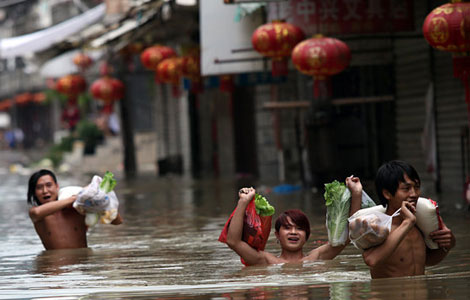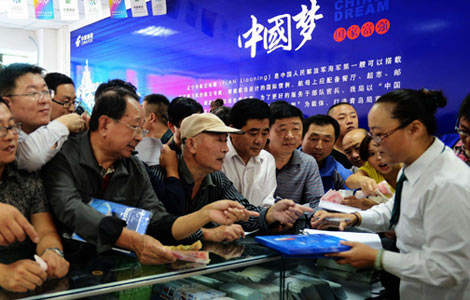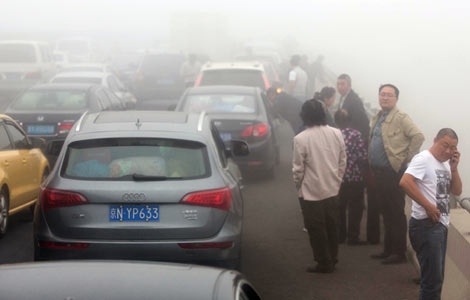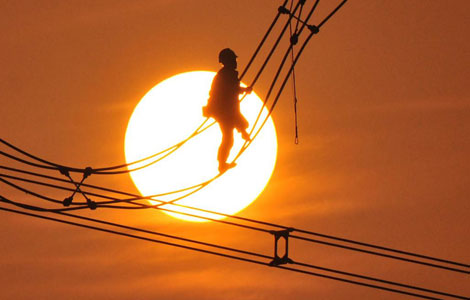Rescuing solar power
Updated: 2013-10-09 14:30
(bjreview.com.cn)
|
||||||||
Market situations differ
Europe is the most important market for China's solar products, comprising 90 percent of total shipments. In 2012, the EU launched anti-dumping and anti-subsidy investigations against China's PV products. After several rounds of negotiations, the EU agreed to stop the investigations but insisted the Chinese side sign a "price undertaking" agreement. China committed to a minimum price of 0.56 euro ($0.76) per watt and a limit to the number of exports to the EU. The agreement came into effect in August.
But the price of 0.56 euro per watt has already had a detrimental affect on China's PV exports to the EU. In September, Jiangsu-based Phono Solar Technology Co Ltd sent delegates to Europe because of a serious drop in orders, but to no avail. The situation at Yingli Green Energy Holding Co Ltd, China's biggest PV company, isn't so bright either. "Although there are no exact figures, our orders are definitely in decline," said Wang Zhixin, the company's spokesman.
Currently 94 Chinese PV enterprises have export quotas to the EU, less than one fifth of the country's more than 500 PV enterprises.
In contrast to declining exports, the domestic market is growing. On July 15, the State Council issued its Several Opinions on Promoting the Healthy Development of the Photovoltaic Industry. They set a goal for an increase of 15 gigawatts a year in 2013-15 for the industry and 20 gigawatts a year after 2015.
On Aug 30, the National Development and Reform Commission, the country's top economic planner, raised the subsidy standard for distributed solar power generation projects from 0.42 yuan to 1 yuan for every kilowatt-hour of electricity, which caused a rush of investment in the industry.
EGing Photovoltaic Technology Co Ltd, listed at the Shanghai Stock Exchange, announced on Sept 18 that the company will raise up to 1.23 billion yuan by a secondary public offering to invest in a 100-megawatt solar power project. Before that, China National Machinery Industry Corp obtained a 20-billion-yuan contract for 2,500-megawatt desert solar power plants across Ningxia Hui autonomous region; Aviation Industry Corp of China announced that in the next three years it will invest 3.8 billion yuan in 20 cities to build 400-megawatt solar power projects. Eight centrally administered State-owned enterprises, including China Huaneng Group, China Datang Corp and China Guodian Corp, have also launched investment plans in building solar power plants.
This isn't the first time that subsidies have caused a flurry of investment in the industry. In 2011, China announced temporary subsidies for large-scale ground PV power plants, leading many enterprises to make hasty investments in building solar power plants. Both qualified and unqualified project contractors participated in the construction upsurge, creating uneven quality.
Privately owned enterprises used to lead the PV industry, but now many State-owned enterprises have entered the sector, leading many to worry about excessive investment once again. Shen Hongwen, a researcher of new energy industries with CIConsulting, says China's PV industry is now undergoing a painful restructuring period. Many companies are faced with being wiped out, but overall restructuring will be good for the industry.
"The situation in the entire industry is much better than during the first half of the year," says Shen, "many factors restraining the sound development of the solar power industry are expected to be resolved."

 Last photos of Hungarian wingsuit diver
Last photos of Hungarian wingsuit diver
 In photos: Typhoon Fitow aftermath
In photos: Typhoon Fitow aftermath
 Japan-US military drill raises tension
Japan-US military drill raises tension
 Higgs and Englert win physics Nobel prize
Higgs and Englert win physics Nobel prize In Bali, they relax in local fashions
In Bali, they relax in local fashions
 Post office for Liaoning carrier opens
Post office for Liaoning carrier opens
 A smog-filled Beijing targets polluting cars
A smog-filled Beijing targets polluting cars
 Animal welfare to be added in training
Animal welfare to be added in training
Most Viewed
Editor's Picks

|

|

|

|

|

|
Today's Top News
Peace is in China's DNA: says ambassador
Trending News across China on Oct 9
Xiaomi's Barra ready to take on Beijing
A day of cultural exchange at Pace University
ZTE, Houston Rockets shooting for global markets
Global firms facing HR challenges in Asia
Back to 1942, entered for the 86th Oscars
Obama says he'll negotiate once 'threats' end
US Weekly

|

|







